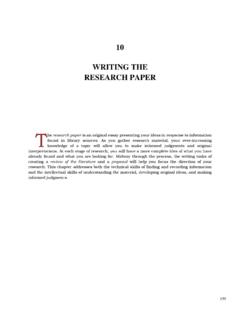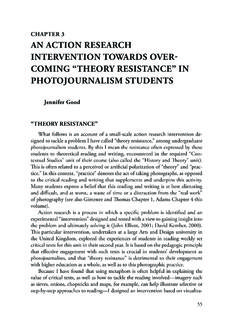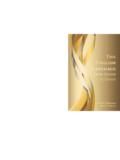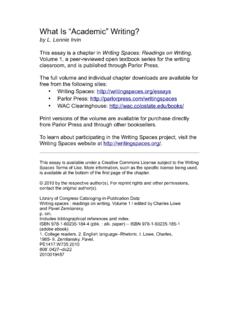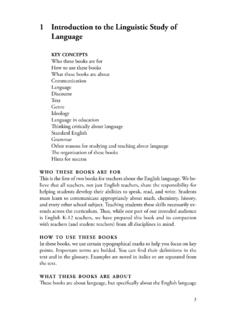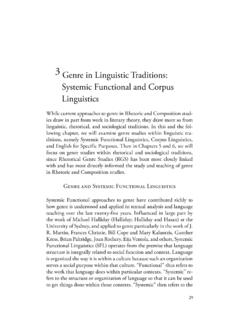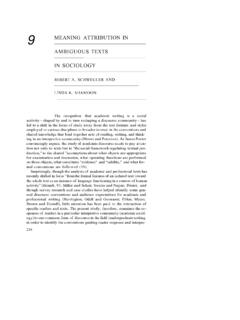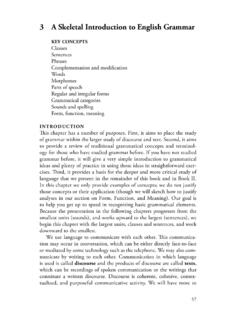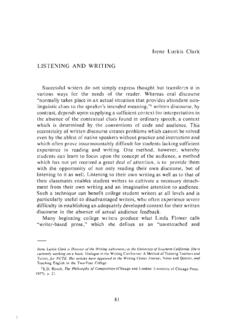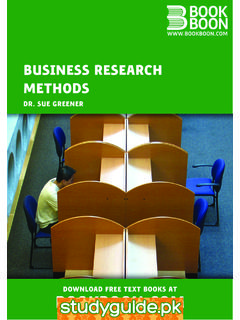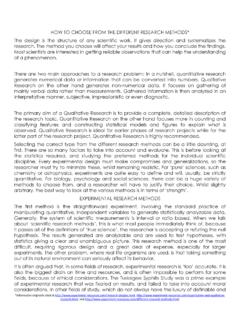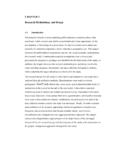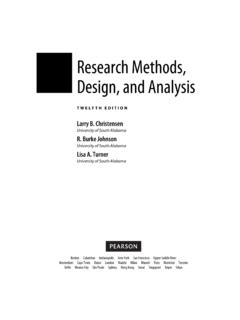Transcription of Research Theory and Methods - WAC Clearinghouse
1 Research Theory and Methods Lucille Parkinson McCarthy University of Maryland Baltimore County Barbara E. Walvoord Loyola College in Maryland In this chapter we (the Research team) present the theoretical framework and Research Methods of this naturalistic study of students' writing in four classrooms. We begin by describing ourselves and our student informants. We then discuss our inquiry paradigm and Research as- sumptions, our assumptions about classrooms, and our Methods of data collection and analysis. Finally, we explain our ways of working as a team and our ways of assuring the trustworthiness of our findings. THE RESEARCHERS AND THE STUDENTS All four teachers on our team whose classrooms we studied: had participated in at least one writing-across-the-curriculum workshop of at least 30 contact hours before the study of their classrooms began had subsequently presented or published on writing across the curriculum (Gazzam [Anderson] and Walvoord 1986; Breihan 1986; Mallonee and Breihan 1985.)
2 Robison 1983) were experienced teachers who received excellent evaluations from their students and colleagues held a doctorate and had published in their fields were in their 40s had been in their positions at least five years were tenured had been department heads (except Anderson) 18 Thinking and Writing in College Walvoord asked these four teachers to collaborate because she judged them to be interested in their students, open to new ideas, and sufficiently self-confident to feel comfortable with her visits to their classes. The team and most of the students are white and from middle- or working-class backgrounds (Table ). Most students were between the ages of 18 and 22 and were enrolled full-time in undergraduate day classes.
3 Within that sector of American higher education, however, Table Characteristics of the Classes in the Study Sherman Breihan Robison Anderson" Institution Loyola College College Towson State U. of Notre Dame Type Catholic liberal Catholic Public compre- arts with strong liberal hensive business arts Location Baltimore City Baltimore Suburb Enrollment" 3876 691 11,086 Mean verbal/ Composite SAT, entering freshmen 516/1064 444/918 437/911 Course Business 330 History 101 Psych 165 Biology 381 Production Modern Human Biological Management Civilization Sexuality Literature Year of data collection 1985 1985 1986 1983, 1986 Level " Course enrollment' 44 27 30 13 Mean verbal SAT, course takers 460 542 448 Female 5 2 '10 5 6 '10 100 /~ 54% Minority 7% 4 % 23% 15% ESL 2 % 0 17% 8% Age 24+ 7% 0 10% 0 a Anderson's 1983 and 1986 classes are the same number of people.
4 The same percentage of female, minority, and ESL students, and those students covered the same age range. Full time equivalent, total undergraduate and graduate school ' Enrollment figures are for year of data collection. '' Course was planned for freshmen-sophomores, but due to unusual circumstances, primarily juniors and seniors enrolled. Research Theory and Methods 19 our discipline-based teachers and our students represent a range: The teachers are two men and two women who teach in three different types of institutions: a large, comprehensive state university; a small, Catholic women's liberal arts college; and a middle-sized, Catholic coeducational college with a large business program.
5 Both teachers and students represent the four major undergraduate discipline areas: business, humanities, social science, and natural science. The classes under study ranged from freshman to senior and included required CORE, elective, and majors courses. OUR INQUIRY PARADIGM AND Research ASSUMPTIONS Our questions, as we began the study, were broad ones about students' thinking and writing. They were the general questions that Geertz says are traditionally asked by ethnographers facing new Research scenes: "What's going on here?" and "What the devil do these people think they're up to?" (1976, 224). We chose the naturalistic inquiry paradigm to ask those questions because it is based on the following assumptions regarding: 1.
6 The nature of reality: Realities are multiple and are constructed by people as they interact within particular social settings. 2. The relationship of knower to known: The inquirer and the "object" of inquiry interact to influence each other. In fact, naturalistic researchers often negotiate Research outcome; with the people whose realities they seek to reconstruct; that is, with the people from whom the data have been drawn. Research is thus never value-free.. 3. The possibilities of generalization: The aim of a naturalistic inquiry is not to develop universal, context-free generalizations, but rather to develop "working hypotheses" that describe the complexities of particular cases or contexts.
7 4. Research Methods and design: Naturalistic researchers use both qualitative and quantitative Methods in order to help them deal with the multiple realities in a setting. Their Research designs therefore emerge as they identify salient features in that setting- features identified for further study. Naturalistic researchers un- derstand themselves as the instruments of inquiry, and acknowl- edge that tacit as well as explicit knowledge is part of the Research process. ' 20 Thinking and Writing in College We assume, then, that Research questions, Methods , and findings are socially constructed by particular researchers in particular settings for particular ends (Harste, Woodward and Burke 1984).
8 We recognize that our own Research practices were shaped by our discipline-based perspectives, by our perspectives as teachers, and by our desire to construct findings that would help the teachers of the four classrooms we studied improve their teaching. Our perspectives shaped, for example, our decision to focus on students' difficulties in meeting teachers' expectations and on those aspects of the classroom context- writing strategies and teaching Methods -that were, we felt, most amenable to the teachers' influence. Because we are aware that our Research findings were shaped by our perspectives, we "reflexively" explain wherever possible our own as well as our informants' knowledge-construction processes, our Research assumptions, our decisions about data collection and analysis, and the collaborative procedures through which we arrived at our findings (Latour and Woolgar 1979, 273-286).
9 Because knowledge in this collaborative study was constructed by multiple researchers with varying perspectives and varying relation- ships to the classrooms under study, we have been careful to define these perspectives and to have all team members tell at least parts of their stories in their own voices. (The relationship among the individual voices and the "we" voice in each coauthored chapter differs somewhat and was worked out separately by each pair.) This type of coauthored, multivoice, reflexive discourse has been called "polyphonic," and we believe it best reflects the intersubjective, "constructive negotiation" involved in producing our Research findings (Clifford 1983, 133-140).
10 Thus, we have worked to adequately represent the multiple and evolving realities of our students and ourselves as we constructed our various types of knowledge and texts. OUR ASSUMPTIONS ABOUT CLASSROOMS Recently, several scholars have attempted to describe the dominant schools of thought currently represented in composition studies. They have discussed those schools in terms of their theories of writing, their approaches to Research and pedagogy, and their social and political implications (Berlin 1988; Faigley 1986; Nystrand 1990). Of the three major perspectives identified by Faigley-the expressive, the cognitive, and the social-our study clearly belongs in the latter category. Our understanding of students learning to write in academic settings Research Theoy and Methods 2 1 is underlain by theoretical assumptions concerning language use from sociolinguistics (Gumperz 1971; Heath 1982; Hymes 1972a, 197210, 1974), literary studies (Fish 1980; Pratt 1977), and philosophy (Rorty 1982).
